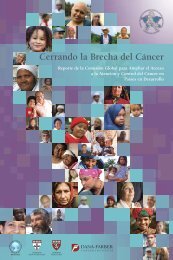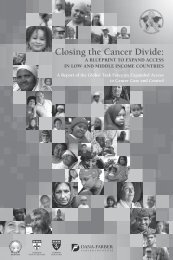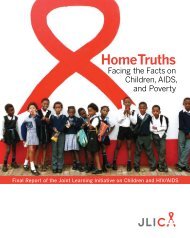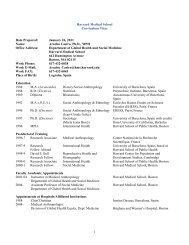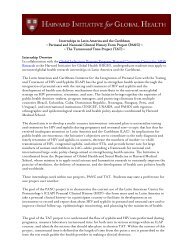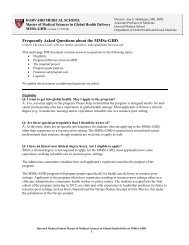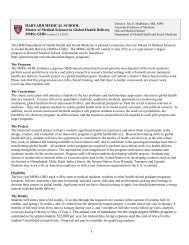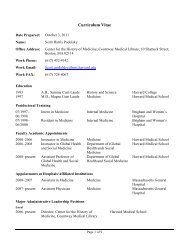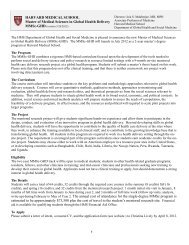Haiti Case Study - The Department of Global Health and Social ...
Haiti Case Study - The Department of Global Health and Social ...
Haiti Case Study - The Department of Global Health and Social ...
Create successful ePaper yourself
Turn your PDF publications into a flip-book with our unique Google optimized e-Paper software.
<strong>of</strong> lowest common denominator, <strong>and</strong> at their best, only served as platforms for<br />
information exchange in the early phase.” 69<br />
76. Some <strong>Haiti</strong>an <strong>of</strong>ficials viewed the cluster system mechanism with scepticism because<br />
they perceived it as a way to create a parallel authority to the six sector-based government<br />
run working groups created the day after the earthquake. “Why have a government if you<br />
have clusters funded <strong>and</strong> led by foreign agencies <strong>and</strong> beholden only to their donors?” noted<br />
one participant. 70 <strong>The</strong> fact that some cluster meetings were conducted in English rather than<br />
French further alienated <strong>Haiti</strong>an government <strong>of</strong>ficials. Eventually agreement was reached<br />
that a <strong>Haiti</strong>an <strong>of</strong>ficial would chair each cluster meeting <strong>and</strong> the lead agency would play a<br />
supporting role. 71<br />
77. Another challenge was negotiating how multiple military organizations—MINUSTAH<br />
<strong>and</strong> particularly the US military—would interface at the strategic <strong>and</strong> operational level.<br />
Developing lines <strong>of</strong> authority <strong>and</strong> carving out scopes <strong>of</strong> work between bilateral military<br />
response forces <strong>and</strong> the peacekeeping mission was an issue in the first days after the<br />
earthquake, but was resolved relatively quickly. A detailed review <strong>of</strong> the colossal US<br />
response effort documented many <strong>of</strong> the struggles inherent in establishing internal lines <strong>of</strong><br />
authority <strong>and</strong> pushing massive amounts <strong>of</strong> resources through fragmented, weak, or<br />
understaffed institutional structures. As one interviewee in the review commented, getting<br />
resources delivered from the US to <strong>Haiti</strong> was like “pushing a bowling ball through a hose”. 72<br />
Another example involved the US military, which worked hard to comply with the plans <strong>of</strong><br />
civilian policy makers, but struggled to obtain guidance for every effort. “<strong>The</strong> US military had<br />
10,000 responders in the field, [USAID] had 34. <strong>The</strong> military was simply able to outrun<br />
everyone else,” remarked one US <strong>of</strong>ficial. 73<br />
INFORMATION GENERATING AND SHARING MECHANISMS<br />
What were information generating <strong>and</strong> sharing mechanisms that allowed the security community to best<br />
participate in health system strengthening?<br />
78. Disaster responders lacked information regarding need assessment <strong>and</strong> where <strong>and</strong><br />
how to respond. Much <strong>of</strong> the first response was based on assumptions <strong>and</strong> estimation which<br />
led to a concentration <strong>of</strong> aid provision focused on the capital, Port-au-Prince, <strong>and</strong> information<br />
which could guide the response in rural areas was not available.<br />
79. For their part, security forces were able to collect relevant information quickly for the<br />
overall need assessments but it seemed that data sharing between the security <strong>and</strong><br />
humanitarian community was inhibited by lack <strong>of</strong> both formal exchange mechanisms <strong>and</strong> an<br />
underst<strong>and</strong>ing <strong>of</strong> how specific information could be <strong>of</strong> value to others.<br />
80. New communication technologies suggest opportunities for improved situational<br />
awareness <strong>and</strong> some <strong>of</strong> these were present in the earthquake response. In particular,<br />
satellite imagery from drones <strong>and</strong> satellites, <strong>and</strong> mapping earthquake-affected areas using<br />
cell phones were successful techniques in generating detailed maps in <strong>Haiti</strong>. Other tools<br />
such as social media networks, crowd sourcing for need assessments <strong>and</strong> mapping cell<br />
phone data to capture migration tendencies <strong>of</strong> displaced people were experimented with<br />
during the response, with mixed success. Information from such tools would have been<br />
useful to plan location, size <strong>and</strong> capability <strong>of</strong> field hospitals that need to be mounted, <strong>and</strong><br />
food/water/aid distributed.<br />
81. Clusters were traditionally the place where stakeholders shared information <strong>and</strong><br />
received an overview <strong>of</strong> the situation but as transportation was a big issue only nearby<br />
organizations could afford to attend <strong>and</strong> the effort was balanced with the value <strong>of</strong> information<br />
provided.<br />
82. <strong>The</strong> <strong>Haiti</strong> cholera outbreak showed how important it is for militaries to be tuned into<br />
epidemiologic data <strong>and</strong> health system functioning as a whole. <strong>The</strong> need for better situation<br />
18



